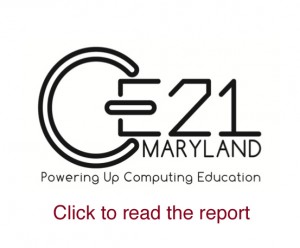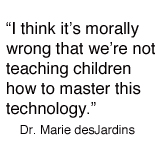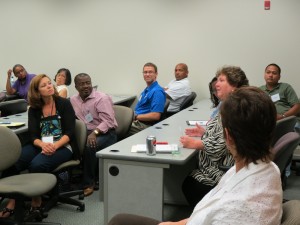You don’t know until you try.
This is what the leaders behind Computing Education for the 21st Century (CE21-Maryland) have figured out. Drs. Marie desJardins, Penny Rheingans, and Susan Martin say that removing the mystery and misconceptions surrounding Computer Science is the key to getting more women and minorities to purse careers in the field.
Historically, Computer Science has been dominated by white males. Just take a look at the numbers. In 2010-11 only 12.7% of computing degrees went to women. A mere 4.6% of Computer Science graduates were African Americans and 6.5% were Hispanics.
 It’s not that women and minorities are no good at Computer Science. It’s that they often think they’re no good. When you walk into a classroom and no one looks like you, it’s easy to feel like you don’t belong.
It’s not that women and minorities are no good at Computer Science. It’s that they often think they’re no good. When you walk into a classroom and no one looks like you, it’s easy to feel like you don’t belong.
Dr. Marie desJardins, a CSEE professor, gives one part of the explanation for this trend. “Youth gaming culture is really dominating Computer Science majors,” she says. Boys who love video games naturally gravitate to Computer Science in college. Women aren’t typically avid gamers. Instead, they tend to gravitate towards social careers–not something they associate with the field of Computer Science.
Herein lies the problem: most of us don’t know what computer scientists actually do. “There are some iconic careers that we understand,” says CSEE Professor Penny Rheingans. “We know what doctors do. We know what lawyers do. But, nobody knows what Computer Scientists do.”
Only by experiencing the discipline firsthand will kids understand if the field is for them. Take Dr. Rheingans, who was headed down the path to becoming a lawyer when she took a Computer Science class: “And I fell in love,” she says. It was hard and sometimes frustrating, but that challenge got her hooked. “Not enough students have the opportunity to experience that.”
 Even if women and minorities want to take Computer Science, they don’t always have the opportunity in high school. Throughout Maryland, inconsistent curriculum and spotty availability has made it hard for students to be introduced to the subject.
Even if women and minorities want to take Computer Science, they don’t always have the opportunity in high school. Throughout Maryland, inconsistent curriculum and spotty availability has made it hard for students to be introduced to the subject.
Computer Science is not a graduation requirement, nor is it even offered at every Maryland high school. Most schools offer it as an elective like ceramics or woodshop. Since the class doesn’t count for credit, those students– who aren’t otherwise encouraged by parents, or a longstanding love of computers–don’t have much incentive to take it.
Computers are becoming an increasingly ubiquitous part of our lives. As such, Dr. desJardins thinks that Computer Science should be a requirement for high school students. “We make them take Government, Math, Science, and English. But, we don’t make them take Computer Science—but it’s the fastest growing job market of any discipline,” she says. “I think it’s morally wrong that we’re not teaching children how to master this technology.”
In March 2012, Drs. desJardins, Rheingans, and Martin formed CE21-Maryland to get a deeper understanding of the shortcomings of Computer Science education in Maryland, and to help solve this problem. The group is supported by NSF’s Computing Education for the 21st Century (CE21) program.
 Last August, CE21-Maryland held its first mini-summit to raise awareness of these issues among Computer Science high school teachers across the state. The summit successfully helped establish connections among teachers who share this passion for change. “Having a community is absolutely important to helping empower people,” says Dr. Rheingans, who has proven the importance of community first-hand as the director of UMBC’s Center for Women in Technology (CWIT).
Last August, CE21-Maryland held its first mini-summit to raise awareness of these issues among Computer Science high school teachers across the state. The summit successfully helped establish connections among teachers who share this passion for change. “Having a community is absolutely important to helping empower people,” says Dr. Rheingans, who has proven the importance of community first-hand as the director of UMBC’s Center for Women in Technology (CWIT).
On May 17, CE21-Maryland will hold its second Summit for Computing Education. Teachers, administrators, legislators, and industry leaders will gather at UMBC to explore these issues, network, and discuss plans for increasing the number and diversity of students studying Computer Science in our state.
The summit will include a college student panel, where current computing majors will share their journey to becoming Computer Science majors. One session will take a look at the AP CS Principles course, a proposed AP course being developed by the College Board and National Science Foundation, with pilots offered around the country.
Dr. desJardins realizes that recognizing the Computer Science curriculum problem is a lot easier than fixing it. “It’s a chicken or the egg problem,” she says. Regulating Computer Science classes across the state can’t happen until teachers are trained to teach it. Training is not likely to happen unless enrollment increases. CE21-Maryland envisions a two-pronged approach to train teachers and make connections with legislators who can make a difference.
The women behind CE21-Maryland are working hard to change the compostion of Computer Science majors. But, why?
“First of all it’s a numbers problem. Second of all it’s a diversity problem,” explains Dr. Rheingans. By 2018, nearly 40,000 new computing-related jobs will be available in Maryland each year. But, only about 2,000 bachelor’s degrees in computing and information systems are awarded by Maryland institutions annually. Recruiting more women and minorities to the major will help satisfy the huge need for computing majors in the future.
But, perhaps more importantt is the chance to add diversity to the next generation of technological problem-solvers. “Different perspectives leads you to stronger, more robust solutions,” she says.